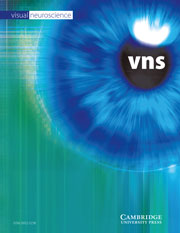Crossref Citations
This article has been cited by the following publications. This list is generated based on data provided by
Crossref.
Akopian, Abram
2003.
Differential modulation of light-evoked on- and off-EPSCs by paired-pulse stimulation in salamander retinal ganglion cells.
Brain Research,
Vol. 967,
Issue. 1-2,
p.
235.
Tucci, S.A.
Genn, R.F.
and
File, S.E.
2003.
Methyllycaconitine (MLA) blocks the nicotine evoked anxiogenic effect and 5-HT release in the dorsal hippocampus: possible role of α7 receptors.
Neuropharmacology,
Vol. 44,
Issue. 3,
p.
367.
Yamada, Elizabeth S.
Dmitrieva, Nina
Keyser, Kent T.
Lindstrom, Jon M.
Hersh, Louis B.
and
Marshak, David W.
2003.
Synaptic connections of starburst amacrine cells and localization of acetylcholine receptors in primate retinas.
Journal of Comparative Neurology,
Vol. 461,
Issue. 1,
p.
76.
CROUSILLAC, SCOTT
LEROUGE, MICHELLE
RANKIN, MICHELE
and
GLEASON, EVANNA
2003.
Immunolocalization of TRPC channel subunits 1 and 4 in the chicken retina.
Visual Neuroscience,
Vol. 20,
Issue. 4,
p.
453.
Pérez-León, Jorge Alberto
Sarabia, Gabriela
Miledi, Ricardo
and
Garcı́a-Alcocer, Guadalupe
2004.
Distribution of 5-hydroxytriptamine2C receptor mRNA in rat retina.
Molecular Brain Research,
Vol. 125,
Issue. 1-2,
p.
140.
Kimura, Fukuko
Shinohara, Kazuyuki
Funabashi, Toshiya
Daikoku, Shigeo
Suyama, Kumiko
Mitsushima, Dai
and
Sano, Akane
2004.
Nicotine inhibition of pulsatile GnRH secretion is mediated by GABAA receptor system in the cultured rat embryonic olfactory placode.
Psychoneuroendocrinology,
Vol. 29,
Issue. 6,
p.
749.
Gastinger, Matthew J.
Bordt, Andrea S.
Bernal, Maria P.
and
Marshak, David W.
2005.
Serotonergic Retinopetal Axons in the Monkey Retina.
Current Eye Research,
Vol. 30,
Issue. 12,
p.
1089.
Marritt, Andrea M.
Cox, Brandon C.
Yasuda, Robert P.
McIntosh, J. Michael
Xiao, Yingxian
Wolfe, Barry B.
and
Kellar, Kenneth J.
2005.
Nicotinic Cholinergic Receptors in the Rat Retina: Simple and Mixed Heteromeric Subtypes.
Molecular Pharmacology,
Vol. 68,
Issue. 6,
p.
1656.
Gastinger, Matthew J.
Tian, Ning
Horvath, Tamas
and
Marshak, David W.
2006.
Retinopetal Axons in Mammals: Emphasis on Histamine and Serotonin.
Current Eye Research,
Vol. 31,
Issue. 7-8,
p.
655.
Janhunen, Sanna
and
Ahtee, Liisa
2007.
Differential nicotinic regulation of the nigrostriatal and mesolimbic dopaminergic pathways: Implications for drug development.
Neuroscience & Biobehavioral Reviews,
Vol. 31,
Issue. 3,
p.
287.
Zhang, Dao-Qi
Zhou, Tong-Rong
and
McMahon, Douglas G.
2007.
Functional Heterogeneity of Retinal Dopaminergic Neurons Underlying Their Multiple Roles in Vision.
The Journal of Neuroscience,
Vol. 27,
Issue. 3,
p.
692.
Frazão, Renata
Pinato, Luciana
da Silva, André V.
Britto, Luiz R.G.
Oliveira, José A.
and
Nogueira, Maria I.
2008.
Evidence of reciprocal connections between the dorsal raphe nucleus and the retina in the monkey Cebus apella.
Neuroscience Letters,
Vol. 430,
Issue. 2,
p.
119.
Cox, Brandon C.
Marritt, Andrea M.
Perry, David C.
and
Kellar, Kenneth J.
2008.
Transport of multiple nicotinic acetylcholine receptors in the rat optic nerve: high densities of receptors containing α6 and β3 subunits.
Journal of Neurochemistry,
Vol. 105,
Issue. 5,
p.
1924.
Cimini, Beth A.
Strang, Christianne E.
Wotring, Virginia E.
Keyser, Kent T.
and
Eldred, William D.
2008.
Role of acetylcholine in nitric oxide production in the salamander retina.
Journal of Comparative Neurology,
Vol. 507,
Issue. 6,
p.
1952.
Liu, Hong
Zhao, Min
and
Opere, Catherine A.
2008.
Prejunctional Inhibitory Effects of Isoprostanes on Dopaminergic Neurotransmission in Bovine Retinae, In vitro.
Neurochemical Research,
Vol. 33,
Issue. 1,
p.
37.
Fregosi, Ralph F.
and
Pilarski, Jason Q.
2008.
Prenatal nicotine exposure and development of nicotinic and fast amino acid-mediated neurotransmission in the control of breathing.
Respiratory Physiology & Neurobiology,
Vol. 164,
Issue. 1-2,
p.
80.
Yazulla, Stephen
2008.
Endocannabinoids in the retina: From marijuana to neuroprotection.
Progress in Retinal and Eye Research,
Vol. 27,
Issue. 5,
p.
501.
HIDAKA, SOH
2009.
SEROTONERGIC SYNAPSES MODULATE GENERATION OF SPIKES FROM RETINAL GANGLION CELLS OF TELEOSTS.
Journal of Integrative Neuroscience,
Vol. 08,
Issue. 03,
p.
299.
Martynyuk, N. Ya.
Purnyn’, E. E.
and
Fedulova, S. A.
2014.
Effect of a Blocker of Nicotine Acetylcholine Receptors on Excitatory Postsynaptic Currents in Ganglion Cells of the Rat Retina.
Neurophysiology,
Vol. 46,
Issue. 6,
p.
516.
Adeniyi, Philip Adeyemi
Olatunji, Babawale Peter
Ishola, Azeez Olakunle
Ajonijebu, Duyilemi Chris
and
Ogundele, Olalekan Michael
2014.
Cadmium Increases the Sensitivity of Adolescent Female Mice to Nicotine-Related Behavioral Deficits.
Behavioural Neurology,
Vol. 2014,
Issue. ,
p.
1.




